
RAB and The North Face have been making jackets, backpacks, and sleeping bags for decades, protecting explorers in every kind of weather.
While the brands share some similarities, they also have key differences that can make one a better fit for your needs than the other.
Today, we’ll compare RAB and The North Face to help you decide which brand to consider for your next piece of outdoor clothing or equipment.
We’ll look at their materials, main products, prices, intended uses, and more.
By the end, you’ll have a clearer idea of which is your best option. Let’s begin!
Key Points:
- RAB was founded in 1981 in Sheffield, England. The brand is dedicated to producing gear “by climbers for climbers”.
- RAB is committed to environmentally friendly production methods.
- RAB uses polyester and nylon, Gore-Tex and Pertex fabric technologies for waterproof/breathable outerwear, and natural down and synthetic insulation.
- The RAB Microlight Alpine jacket is an iconic product.
- RAB makes its products in the UK and Asia.
- The North Face is an American brand founded in 1966. It’s known for both its high-performance outdoor gear and its fashionable clothing.
- The North Face is also focused on eco-friendly production.
- The North Face uses polyester and nylon, Gore-Tex, DryVent, and FUTURELIGHT fabric technologies, and natural down and synthetic insulation.
- The North Face’s McMurdo parka, Nuptse jacket, and Borealis backpack are iconic products.
- The North Face makes its products mostly in Asia, with some collections made in the USA.
- Prices are similar.
- Decision: RAB focuses more on technical climbing and mountaineering gear, while The North Face caters to a wider range of outdoor activities and also focuses on fashion pieces.
Contents:
1. RAB Outdoor Gear
History of the Brand
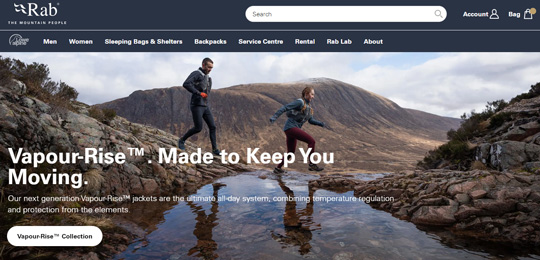
RAB official website
RAB‘s origins can be traced back to 1981, when Rab Carrington, a Scottish mountaineer, established the brand in Sheffield, South Yorkshire, England, using his own name.
Due to a UK strike in 1973, Rab Carrington, stranded in Buenos Aires without equipment, learned to craft high-quality sleeping bags with the guidance of his friend, Hector Vieytes. These skills motivated him to create Rab, a company dedicated to producing gear “by climbers for climbers.”
The brand has since developed iconic products for mountaineers and climbers. In 2001, Rab partnered with Polartec, whose materials continue to be integral to Rab gear.
Since 2003, Equip Outdoor Technologies Ltd has owned Rab, upholding the brand’s ethos and designing renowned jackets like the Microlight Alpine, solidifying Rab’s position as one of Europe’s leading providers of specialized outdoor wear.
Don’t miss:
7 Brands like RAB for Outdoor Adventures
8 British Outdoor Clothing Brands that You’ll Love
Materials, Fabrics, and Production Process
Every year, Rab diligently strives to shift towards environmentally friendly production methods, including ethically acquiring materials and utilizing PFC-free water-repellent treatments.
This commitment is further evidenced by the incorporation of recycled materials and the dedication to creating durable products.
The brand predominantly utilizes polyester and nylon as primary materials, with a greater emphasis on the latter in their gear. Waterproof outerwear is indispensable in the winter season, and Rab leverages various fabric technologies to ensure dryness in any weather condition.
These technologies encompass Gore-Tex, recognized as a top waterproof fabric, along with Pertex Shield, Proflex, and Pertex Shield+, each offering distinct performance attributes.
Rab’s waterproof fabrics are offered in three different constructions – 2, 2.5, and 3 layers – tailored to their specific purposes.
As for breathability, the company uses Hydrophilic and Microporous technologies, both being very effective as moisture-wicking solutions.
Regarding insulation, Rab presents a diverse range of natural down and synthetic insulated jackets and sleeping bags. The natural down is responsibly sourced, and over the years, the brand has used more and more recycled fabrics and recycled down insulation.
While natural down is an exceptional insulator, it possesses certain drawbacks, like losing its insulator properties when wet, leading to the widespread use of synthetic insulation. In this regard, Rab predominantly relies on Stratus synthetic insulation and Cirrus for its synthetic-insulated sleeping bags and jackets.
Some jackets are also insulated with Pyrotec synthetic insulation, while PrimaLoft is commonly utilized in Rab’s gloves.
The video will be loaded from YouTube.com, a third party. If you play it, you accept their terms of service, and their use of cookies.
Read also:
RAB vs Patagonia Outdoor Equipment: A Comparison
RAB vs Columbia Outdoor Gear: Which is Better?
Where is RAB outdoor gear made?
Rab’s gear is made partly in the UK, where the company is based, and the rest in Asian countries, mainly in China.
Recommended Products
RAB Men’s Microlight Alpine Down Jacket
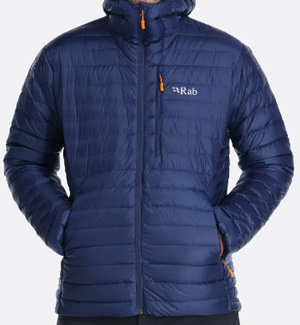
Image: rab.equipment
Check it out at rab.equipment
The Microlight Alpine is a lightweight winter jacket equipped with 700 fill-power hydrophobic down, offering warmth and water resistance in wet conditions. Its Pertex Quantum shell technology enhances durability and breathability, catering to various activities.
The jacket has a chest pocket and two hand pockets, with the latter being harness-compatible. Available in men’s and women’s sizes, the Microlight Alpine is highly compressible for convenient portability.
RAB Aeon 35L Daypack
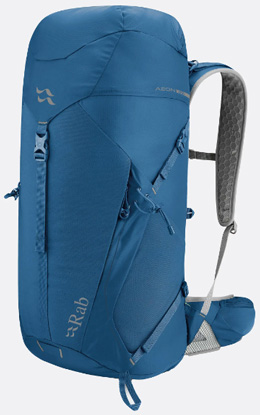
Image: rab.equipment
Check it out at rab.equipment
The RAB Aeon 35L Daypack is functional for different mountain expeditions. Featuring the Air Contour X carry system, it offers a secure fit and optimal support for heavy loads, increasing stability on challenging terrain.
The semi-rigid back panel lets air flow and conforms to the user’s body shape. With an adjustable back length and forward pull hip belt, along with a wrap-around stretch yoke, it delivers a personalized and comfortable fit.
With a 35-liter capacity, it’s great for camping and hiking, featuring TipGripper walking pole attachments, a walking axe loop, and practical stretch pockets.
Its zippered hip belt pockets offer accessible storage for small essentials, while the bag is crafted from 50% recycled nylon fabric and includes a rain cover for all-weather use.
Prices
Rab is not a budget-friendly name, but it’s not among the priciest we’ve seen. It’s among the mid-to-high-end outdoor brands.
The brand’s coats start at approximately $80 (for windbreakers and lighter options) and can reach up to $850 (for down jackets and technical styles).
The backpacks are priced in the range of $60 to $250 based on the design. The remaining gear and accessories have significant variability.
Are RAB products worth the price?
In our opinion, RAB is definitely worth it! The brand creates some of the most durable and high-quality gear. Their jackets’ and sleeping bags’ insulation is among the best in the market. But it also depends on what you’re looking for in a product.
Read also: Jack Wolfskin vs RAB Outdoor Gear (A Comparison)
2. The North Face Outdoor Gear
History of the Brand
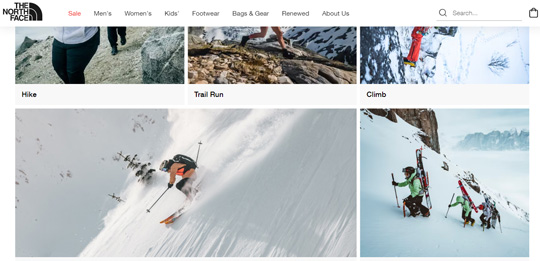
The North Face official website
The North Face stands out as a prominent American brand within the outdoor gear sector, enjoying widespread popularity among outdoor enthusiasts for several decades.
Since its establishment in 1966, the company has maintained a strong emphasis on crafting high-performance mountain apparel and gear, including trekking packs, tents, sleeping bags, skiwear, and other outerwear.
In the 1990s, The North Face’s appeal transcended its technical wear origins, attracting a diverse clientele, including celebrities who prominently featured the brand’s products. For instance, in 1993, a rapper showcased the Steep Tech jacket in a music video.
The brand’s name originates from the concept of “the north face” of a mountain in the northern hemisphere, representing the most frigid and difficult to climb.
Don’t miss:
11 Brands like The North Face: Our Top Alternatives
12 Best American Jackets and Outdoor Clothing Brands
Materials, Fabrics, and Production Process
The North Face primarily utilizes Nylon and Polyester, like most outdoor gear brands, and integrates various technologies into its products.
One notable technology is the FUTURELIGHT membrane, which features a thin nanomembrane allowing air to flow while repelling water. It has been rigorously tested and proven to withstand harsh outdoor conditions.
Next, the brand incorporates goose down for thermal insulation, offering customers the comfort and warmth needed for extended trips. This type of insulation is lightweight, providing users with freedom of movement during challenging activities.
The North Face also incorporates the renowned Gore-Tex technology in many products, providing waterproofing, windproofing, and breathability. Gore-Tex effectively allows moisture to pass through while preventing water from entering.
The company has also developed other technologies such as DryVent, WindWall, FlashDry, and the popular ThermoBall synthetic insulation.
The video will be loaded from YouTube.com, a third party. If you play it, you accept their terms of service, and their use of cookies.
Read also:
Fjällräven vs The North Face (Outdoor Gear Comparison)
The North Face vs Helly Hansen: Which is Better?
Where is The North Face outdoor gear made?
Most of The North Face’s outdoor gear is made in Asian countries like China, India, Vietnam, and Bangladesh, with some product lines also being produced in the USA.
Recommended Products
The North Face Men’s McMurdo Parka
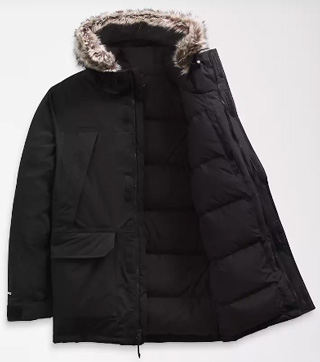
Image: thenorthface.com
Check it out at TheNorthFace.com
The Men’s McMurdo Parka is crafted to deliver exceptional warmth and protection from the elements. This coat has a comfortable fit and is filled with 600-fill recycled waterfowl down, making it an excellent option for chilly conditions.
The parka is designed to be waterproof, windproof, and breathable, utilizing a seam-sealed DryVent™ 2L shell with a non-PFC DWR finish. It is equipped with practical features such as concealed, secure-zip chest pockets, two dual-entry front pockets, and a secure-zip internal chest pocket.
The parka also features an attached hood with an internal drawcord for adjustability and a detachable faux-fur ruff, along with a stormflap that covers the VISLON® front zip. It comes with an embroidered logo on the left chest and back-right shoulder, adding a stylish touch.
Adjustable hook-and-loop cuff tabs ensure a comfortable fit, making the McMurdo Parka a versatile choice for cold and bad weather.
Read also: The North Face Diablo vs. Nuptse: Which Jacket is Better?
The North Face Borealis Backpack
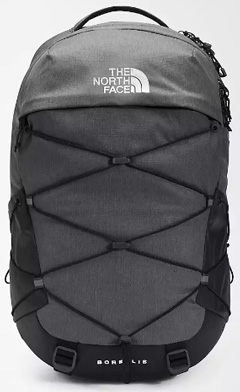
Image: thenorthface.com
Check it out at TheNorthFace.com
The Borealis Backpack is a popular and adaptable pack for your everyday needs with both security and practicality in mind. Its distinctive bungee cord system and spacious interior ensure the safety of your belongings.
The backpack’s upright build, detachable waist belt, chest strap, and safeguarded laptop compartment make it suitable for various pursuits and settings. Equipped with the FlexVent™ suspension system, this backpack emphasizes comfort and stability, for a snug fit even during prolonged use.
For organization, the Borealis presents an external bungee-compression system, side bungee cords, and bottom compression. It also has a safeguarded dedicated laptop compartment, a roomy main compartment, and a front section with internal organization, secure-zip pockets, and a tablet sleeve.
Made from a blend of recycled nylon and recycled polyester, this backpack not only offers functionality but also aligns with sustainable principles. With its combination of practical attributes and considerate design, the Borealis Backpack is a dependable option for daily use.
Read also: How To Wash a North Face Backpack: Step by Step
Prices
The products from The North Face are priced higher compared to numerous other outdoor gear companies. Typically, the brand falls within the mid-to-high price range. Their jackets range from around $70 to $800, while their backpacks are priced between $50 and about $300.
Are The North Face products worth the price?
If you’re an expert mountaineer, skier, hiker, or outdoor enthusiast, we believe that The North Face gear is worth it. Their equipment is engineered to deliver the comfort and performance you require.
For casual clothing or casual outdoor gear, it depends. But even in that case, there are a few affordably priced options available from this brand, making it a good choice to keep in mind even for less specialized equipment.
Learn more: Why Is The North Face So Expensive and Popular? Are Its Jackets Worth It?
3. Which is Better? RAB or The North Face?
Now, we’re at the decision part. While both are great, if we had to choose, here are a few considerations that could make the decision easier:
Quality: Both are recognized for their high-quality, durable outdoor gear. RAB focuses specifically on gear for climbers and mountaineers, while The North Face to a wider range of outdoor enthusiasts.
Materials: Both use similar high-performance materials like nylon, polyester, down, and synthetic insulation. They also use advanced technologies like Gore-Tex, DryVent, Pertex, etc., to make their gear waterproof and breathable.
Sustainability: Both brands are moving towards more sustainable practices, such as using recycled materials and limiting the use of PFCs.
Prices: The prices are similar for jackets with both brands reaching more than $800 for their technical and insulated designs. Backpacks are also similar in price on average. RAB has pricier sleeping bags.
In the end, RAB has a stronger focus on technical climbing and mountaineering gear, so this brand is our recommendation for these types of outdoor activities.
The North Face caters to a wider range of outdoor activities and also focuses more in fashion pieces. So, it can be better if you want stylish options. But the brand has also great technical gear.
That’s it for this comparison! Let us know what you think in the comments.
Read next:
9 High-End, Expensive Hiking Brands for Clothing and Footwear
8 Best Sustainable Outdoor Clothing Brands: Our Top Picks

